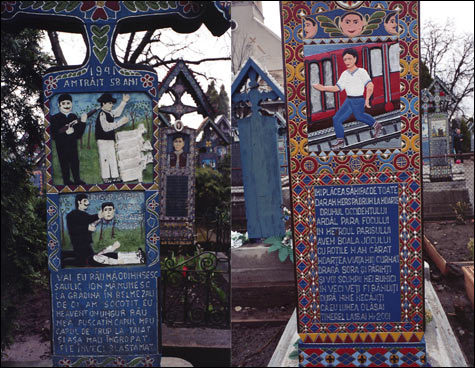
MEMENTO Imagery and poetry combine to tell the story of a community. |
| The Merry Cemetery of Sapanta | Photographs by Peter Kayafas, Epitaph translations by Adrian G. Sahlean, essay by Sanda Golopentia | Purple Martin Press | 120 pages | $45 |
Entering the small back room at Gallery Kayafas, where Peter Kayafas’s photographic tributes to the poignant sculptures that dot a solitary cemetery in a remote Romanian village are on display, you feel you’ve been transported into the shadowy pages of a small, mysterious book. In fact, you have. Kayafas’s show marks the publication of The Merry Cemetery of Sapanta (Purple Martin Press), which celebrates the riveting and crude carved wooden grave markers in an isolated village in northern Transylvania. It also chronicles the germination and fruition of a real folk art.A carver of gates and crosses, Ion Stan Patras (1908–1977) eventually began carving the likenesses of his fellow villagers for their tombs. Over time, the likenesses became representations of a central theme in the life of the deceased (a woman who sang in her church choir, a man who loved his oxen) or, more dramatically, a re-enactment of the moment of death. Lightning strikes one ill-fated farmer; a rabid horse spits in the face of another; vehicular accidents abound; a youth meets his end rollerblading in a Paris subway; the shepherd Saulic Ion was shot and beheaded by a Hungarian.
But the enchanting power of these colorfully painted scenes is only partly explained by Patras’s carving. Below each portrait or tableau, a poem has been etched into the wood, and thanks to a linguistic device that’s as simple as Patras’s sculptural style, The Merry Cemetery of Sapanta casts a hypnotic spell. Each poem is delivered in the first person, the voice of the dead. Some are philosophical (“Man goes through life with many trials/More bad than good”), some bitter (“Maybe mother cursed me/When she rocked the cradle”), some penitent (“Forgive me father/I did not listen to you”). All are terse, idiosyncratic, and utterly personal — you’re delivered into the frequent sorrows, occasional joys, and continuing passions of a people. How Patras developed the literary complement to his effigies remains unclear, though Sanda Golopentia’s graceful essay alludes to funeral rites in the region of Sapanta in which the officiating deacon sings to the bereaved in the voice of the deceased.
The poems’ translator, Adrian G. Sahlean, has rendered the rhymed trochaic couplets of the Romanian into English that’s earthy, uncomplicated, and direct. The result reads as uncompromised and strange.
But Kayafas the photographer takes a back seat to Kayafas the anthropologist: each of the 41 images in the text is identically formatted, depicting the entirety of each grave marker from base to summit. With the exception of the book’s cover, frontispiece, and end page, there are no close-ups of Patras’s figures, no croppings of the graves that surround the central piece in each photo, and the only light is the gray overcast in which the photos were taken. That decision is a boon for the book more than it is for the exhibit. With the translated epitaphs to the left and the full frontal accompanying image to the right, The Merry Cemetery of Sapanta makes you feel the uncanny presence of individuals you’ve never met in a place few of us will ever go.
“PETER KAYAFAS: THE MERRY CEMETERY OF SAPANTA” | Gallery Kayafas, 450 Harrison Ave, Boston | Through July 26